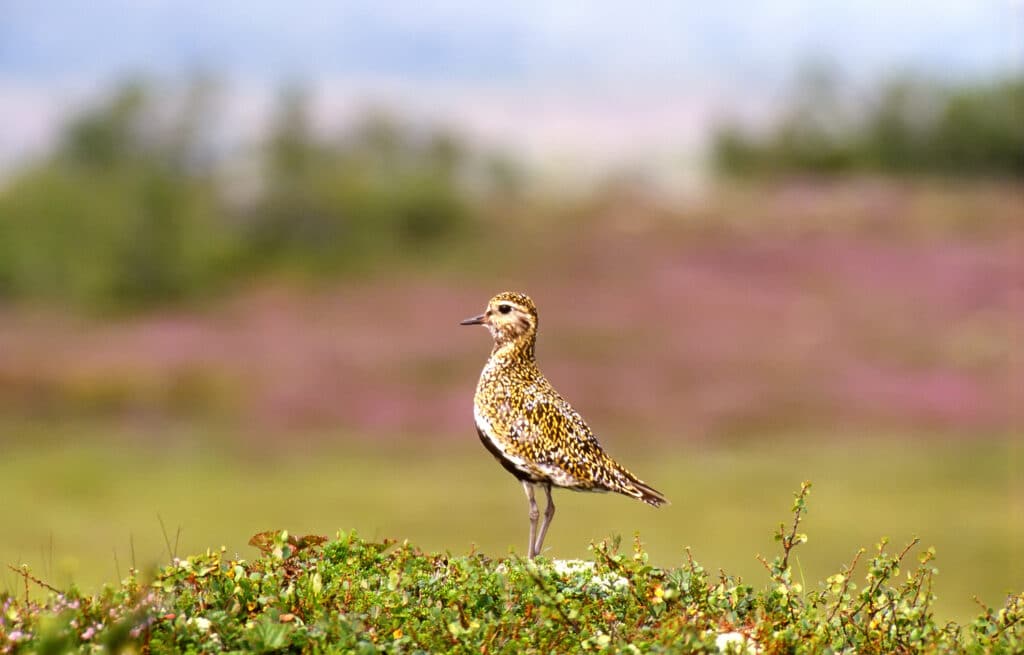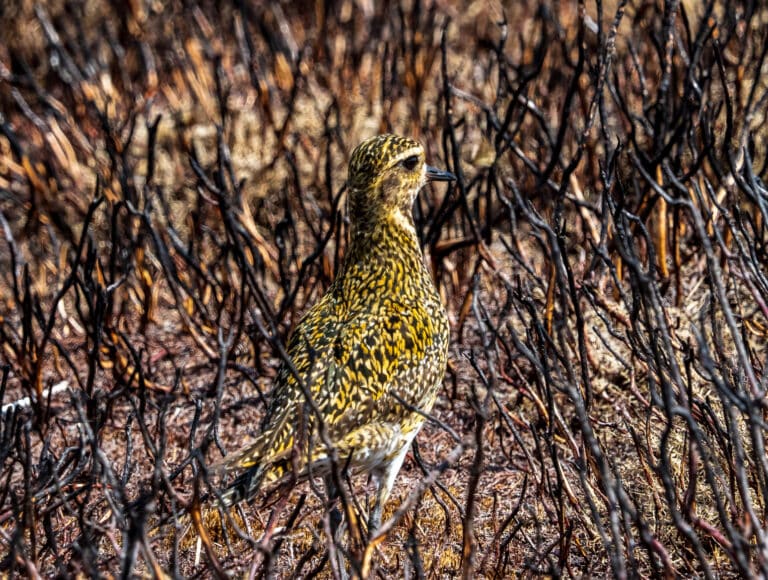Facts about the Golden Plover
Scientific name: Pluvialis apricaria
Bird Family: Plovers
UK conservation status: Green
At a glance
- Breeds mainly in the uplands, wintering on lowland farmland and coastal marshes.
- Likely to be particularly vulnerable to climate change because of their insect-based diet.
- Still on 'quarry list' - shooters reacted furiously to a 2016 petition asking for a moratorium.

A medium-sized plover (similar in size to a long-legged Feral Pigeon) with a distinctive gold and black summer plumage, in non-breeding plumage adult Golden Plovers lose their black underparts and have golden brown upperparts and whitish underparts. Juveniles resemble adults in winter plumage but are slightly duller and paler.
Golden Plovers have a very limited breeding range here, nesting on upland moorlands in the southern uplands and Highlands of Scotland, the Western and Northern Isles, the Peak District, and N Yorkshire, and in smaller numbers in Wales, and Devon on Exmoor. In winter Golden Plovers move to lowland farmland and coastal marshes, often forming large mixed flocks with Lapwings, and spending much of the day roosting on open, ploughed fields that provide clear views of approaching predators.

While recent surveys suggest that after moderate declines towards the end of the last century, the breeding population of Golden Plovers (put at between 33000 to 51000 pairs in 2016) appear to be only in slight decline leading to the Green Conservation Assessment.
However, as long ago as 2011 a report from the British Trust for Ornithology (BTO) suggested they are likely to be particularly vulnerable to climate change because they consume large numbers of adult craneflies which emerge from the surface layers of moorland peat in May and June (after spending several years underground as larvae or ‘leatherjackets)’. High summer temperatures dry out the surface layers of the peat, killing young cranefly larvae, resulting in fewer adults emerging the following year.
Since that report a decade ago, average temperatures have been slowly rising: 2022 saw record temperatures and the drying out of large areas of the UK. Changing conditions will undoubtedly impact craneflies (and other invertebrates) at different stages of their life all of which could mean less food available for both Golden Plover chicks and adults.
Surely, then, taking a precautionary approach and banning the shooting of Golden Plover – a species that there is no logical reason to shoot whatsoever – would make sense?
Apparently not. In fact the Golden Plover is still listed as a so-called ‘quarry’ species (a term that shooters use to lump together unrelated species that are connected only on shooting’s say-so) with a ’season’ when they are legally allowed to be killed.
Shooting lobbyists GWCT reacted furiously to a petition asking for a moratorium in 2016, saying that numbers have remained broadly stable across Europe, and that if there had been declines in Golden Plovers it had nothing to do with shooting but disturbance by hikers and increased numbers of grazing sheep. They also pushed for more ‘predator control’ – an argument continually applied to an ever wider group of moorland birds when what they are really trying to justify is the killing of animals like foxes so that larger numbers of Red Grouse will be available to shooters.
Despite the hand wringing, shooters themselves admit, though, that few are shot. In 2018 BASC, for example, started data-collection’ through an “annual wing survey” (which is as disturbing as it sounds and probably pointless anyway as shooters might discard or not reach birds they kill over water and marshes skewing the results) and their website simply lists Golden Plover as ‘extras’ – in other words too few to bother about.
Sadly, neither showed any consideration of sentience or took any notice of the moral or ethical arguments that shooting Golden Plovers – whether just a handful or not – makes no sense at all.

